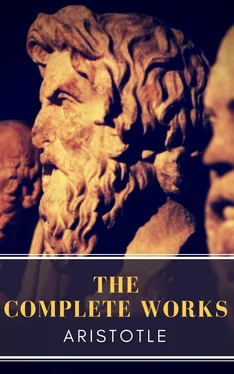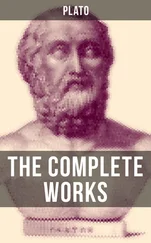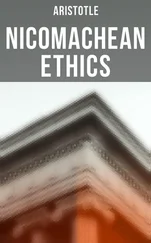Aristotle Aristotle - Aristotle - The Complete Works
Здесь есть возможность читать онлайн «Aristotle Aristotle - Aristotle - The Complete Works» — ознакомительный отрывок электронной книги совершенно бесплатно, а после прочтения отрывка купить полную версию. В некоторых случаях можно слушать аудио, скачать через торрент в формате fb2 и присутствует краткое содержание. Жанр: unrecognised, на английском языке. Описание произведения, (предисловие) а так же отзывы посетителей доступны на портале библиотеки ЛибКат.
- Название:Aristotle: The Complete Works
- Автор:
- Жанр:
- Год:неизвестен
- ISBN:нет данных
- Рейтинг книги:3 / 5. Голосов: 1
-
Избранное:Добавить в избранное
- Отзывы:
-
Ваша оценка:
- 60
- 1
- 2
- 3
- 4
- 5
Aristotle: The Complete Works: краткое содержание, описание и аннотация
Предлагаем к чтению аннотацию, описание, краткое содержание или предисловие (зависит от того, что написал сам автор книги «Aristotle: The Complete Works»). Если вы не нашли необходимую информацию о книге — напишите в комментариях, мы постараемся отыскать её.
This edition has been professionally formatted and contains several tables of contents. The first table of contents (at the very beginning of the ebook) lists the titles of all novels included in this volume. By clicking on one of those titles you will be redirected to the beginning of that work, where you'll find a new TOC that lists all the chapters and sub-chapters of that specific work.
Aristotle: The Complete Works — читать онлайн ознакомительный отрывок
Ниже представлен текст книги, разбитый по страницам. Система сохранения места последней прочитанной страницы, позволяет с удобством читать онлайн бесплатно книгу «Aristotle: The Complete Works», без необходимости каждый раз заново искать на чём Вы остановились. Поставьте закладку, и сможете в любой момент перейти на страницу, на которой закончили чтение.
Интервал:
Закладка:
It is also clear that when A inheres in B, this can be demonstrated if there is a middle term. Further, the ‘elements’ of such a conclusion are the premisses containing the middle in question, and they are identical in number with the middle terms, seeing that the immediate propositions-or at least such immediate propositions as are universal-are the ‘elements’. If, on the other hand, there is no middle term, demonstration ceases to be possible: we are on the way to the basic truths. Similarly if A does not inhere in B, this can be demonstrated if there is a middle term or a term prior to B in which A does not inhere: otherwise there is no demonstration and a basic truth is reached. There are, moreover, as many ‘elements’ of the demonstrated conclusion as there are middle terms, since it is propositions containing these middle terms that are the basic premisses on which the demonstration rests; and as there are some indemonstrable basic truths asserting that ‘this is that’ or that ‘this inheres in that’, so there are others denying that ‘this is that’ or that ‘this inheres in that’-in fact some basic truths will affirm and some will deny being.
When we are to prove a conclusion, we must take a primary essential predicate-suppose it C-of the subject B, and then suppose A similarly predicable of C. If we proceed in this manner, no proposition or attribute which falls beyond A is admitted in the proof: the interval is constantly condensed until subject and predicate become indivisible, i.e. one. We have our unit when the premiss becomes immediate, since the immediate premiss alone is a single premiss in the unqualified sense of ‘single’. And as in other spheres the basic element is simple but not identical in all-in a system of weight it is the mina, in music the quarter-tone, and so on—so in syllogism the unit is an immediate premiss, and in the knowledge that demonstration gives it is an intuition. In syllogisms, then, which prove the inherence of an attribute, nothing falls outside the major term. In the case of negative syllogisms on the other hand, (1) in the first figure nothing falls outside the major term whose inherence is in question; e.g. to prove through a middle C that A does not inhere in B the premisses required are, all B is C, no C is A. Then if it has to be proved that no C is A, a middle must be found between and C; and this procedure will never vary.
(2) If we have to show that E is not D by means of the premisses, all D is C; no E, or not all E, is C; then the middle will never fall beyond E, and E is the subject of which D is to be denied in the conclusion.
(3) In the third figure the middle will never fall beyond the limits of the subject and the attribute denied of it.
24
Since demonstrations may be either commensurately universal or particular, and either affirmative or negative; the question arises, which form is the better? And the same question may be put in regard to so-called ‘direct’ demonstration and reductio ad impossibile. Let us first examine the commensurately universal and the particular forms, and when we have cleared up this problem proceed to discuss ‘direct’ demonstration and reductio ad impossibile.
The following considerations might lead some minds to prefer particular demonstration.
(1) The superior demonstration is the demonstration which gives us greater knowledge (for this is the ideal of demonstration), and we have greater knowledge of a particular individual when we know it in itself than when we know it through something else; e.g. we know Coriscus the musician better when we know that Coriscus is musical than when we know only that man is musical, and a like argument holds in all other cases. But commensurately universal demonstration, instead of proving that the subject itself actually is x, proves only that something else is x—e.g. in attempting to prove that isosceles is x, it proves not that isosceles but only that triangle is x—whereas particular demonstration proves that the subject itself is x. The demonstration, then, that a subject, as such, possesses an attribute is superior. If this is so, and if the particular rather than the commensurately universal forms demonstrates, particular demonstration is superior.
(2) The universal has not a separate being over against groups of singulars. Demonstration nevertheless creates the opinion that its function is conditioned by something like this-some separate entity belonging to the real world; that, for instance, of triangle or of figure or number, over against particular triangles, figures, and numbers. But demonstration which touches the real and will not mislead is superior to that which moves among unrealities and is delusory. Now commensurately universal demonstration is of the latter kind: if we engage in it we find ourselves reasoning after a fashion well illustrated by the argument that the proportionate is what answers to the definition of some entity which is neither line, number, solid, nor plane, but a proportionate apart from all these. Since, then, such a proof is characteristically commensurate and universal, and less touches reality than does particular demonstration, and creates a false opinion, it will follow that commensurate and universal is inferior to particular demonstration.
We may retort thus. (1) The first argument applies no more to commensurate and universal than to particular demonstration. If equality to two right angles is attributable to its subject not qua isosceles but qua triangle, he who knows that isosceles possesses that attribute knows the subject as qua itself possessing the attribute, to a less degree than he who knows that triangle has that attribute. To sum up the whole matter: if a subject is proved to possess qua triangle an attribute which it does not in fact possess qua triangle, that is not demonstration: but if it does possess it qua triangle the rule applies that the greater knowledge is his who knows the subject as possessing its attribute qua that in virtue of which it actually does possess it. Since, then, triangle is the wider term, and there is one identical definition of triangle-i.e. the term is not equivocal-and since equality to two right angles belongs to all triangles, it is isosceles qua triangle and not triangle qua isosceles which has its angles so related. It follows that he who knows a connexion universally has greater knowledge of it as it in fact is than he who knows the particular; and the inference is that commensurate and universal is superior to particular demonstration.
(2) If there is a single identical definition i.e. if the commensurate universal is unequivocal-then the universal will possess being not less but more than some of the particulars, inasmuch as it is universals which comprise the imperishable, particulars that tend to perish.
(3) Because the universal has a single meaning, we are not therefore compelled to suppose that in these examples it has being as a substance apart from its particulars-any more than we need make a similar supposition in the other cases of unequivocal universal predication, viz. where the predicate signifies not substance but quality, essential relatedness, or action. If such a supposition is entertained, the blame rests not with the demonstration but with the hearer.
(4) Demonstration is syllogism that proves the cause, i.e. the reasoned fact, and it is rather the commensurate universal than the particular which is causative (as may be shown thus: that which possesses an attribute through its own essential nature is itself the cause of the inherence, and the commensurate universal is primary; hence the commensurate universal is the cause). Consequently commensurately universal demonstration is superior as more especially proving the cause, that is the reasoned fact.
(5) Our search for the reason ceases, and we think that we know, when the coming to be or existence of the fact before us is not due to the coming to be or existence of some other fact, for the last step of a search thus conducted is eo ipso the end and limit of the problem. Thus: ‘Why did he come?’ ‘To get the money-wherewith to pay a debt-that he might thereby do what was right.’ When in this regress we can no longer find an efficient or final cause, we regard the last step of it as the end of the coming-or being or coming to be-and we regard ourselves as then only having full knowledge of the reason why he came.
Читать дальшеИнтервал:
Закладка:
Похожие книги на «Aristotle: The Complete Works»
Представляем Вашему вниманию похожие книги на «Aristotle: The Complete Works» списком для выбора. Мы отобрали схожую по названию и смыслу литературу в надежде предоставить читателям больше вариантов отыскать новые, интересные, ещё непрочитанные произведения.
Обсуждение, отзывы о книге «Aristotle: The Complete Works» и просто собственные мнения читателей. Оставьте ваши комментарии, напишите, что Вы думаете о произведении, его смысле или главных героях. Укажите что конкретно понравилось, а что нет, и почему Вы так считаете.












